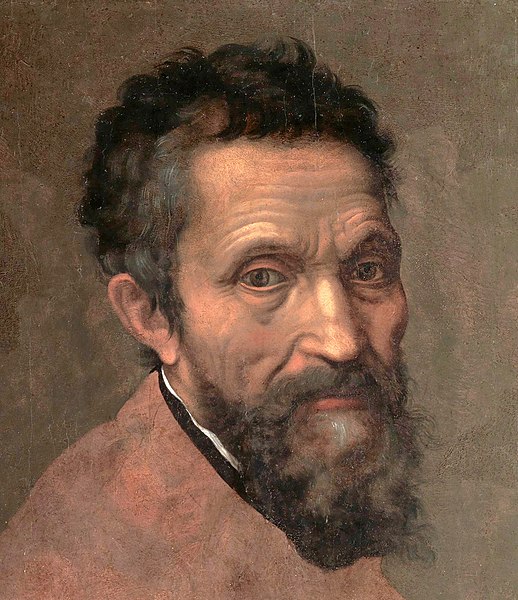
Born: 6 March 1475, Caprese, Florence
Died: 18 February 1564 (aged 88)
Period: Renaissance
The Life of Michelangelo
Michelangelo Buonarroti, born on March 6, 1475, in Caprese, Italy, is universally celebrated as one of the greatest artists of the Italian Renaissance. His extensive contributions spanned the fields of sculpture, painting, architecture, and poetry, profoundly influencing the development of Western art. Michelangelo’s works are distinguished by their unprecedented combination of technical mastery and emotional intensity.
Early Life and Training Michelangelo was born to a family of minor nobility but was primarily raised in Florence, a vibrant cultural center of the Renaissance. He showed an early interest in art, prompting his father to place him in the workshop of painter Domenico Ghirlandaio. However, Michelangelo was more drawn to sculpture, and his talents were soon recognized by Lorenzo de’ Medici, the de facto ruler of Florence. Michelangelo was invited to study at the Medici gardens, a place where he could access classical sculptures and learn from prominent artists of the time.
Sculptural Works Michelangelo’s sculptural works are celebrated for their realism and emotional depth. Early masterpieces like the “Pietà” (1498-1499), housed in St. Peter’s Basilica, Vatican City, and the colossal “David” (1501-1504), in Florence, showcase his ability to convey complex human emotions through marble. His sculptures were noted for their detailed anatomy and expressive power, reflecting Michelangelo’s deep understanding of the human form.
Painting and The Sistine Chapel Ceiling In 1508, Michelangelo was commissioned by Pope Julius II to paint the ceiling of the Sistine Chapel in Vatican City. This monumental work, completed in 1512, comprises a series of frescoes that depict scenes from the Book of Genesis, prophets, and sibyls. The central panels, including the iconic “Creation of Adam,” are renowned for their dynamic composition and the lifelike figures that seem to occupy three-dimensional space. This project solidified Michelangelo’s reputation as a master painter.
Later Architectural Works and Poetry Michelangelo also made significant contributions to architecture. In 1546, he was appointed the architect of St. Peter’s Basilica in Vatican City, where he designed the dome, which would become influential in Western architectural history. Additionally, Michelangelo’s poetry, consisting of sonnets and madrigals, reveals his contemplative and personal side, offering insights into his thoughts on love, art, and religion.
Legacy and Death Michelangelo’s life was marked by his relentless pursuit of artistic perfection and his deep religious faith, which influenced much of his work. Despite his fame, he often struggled with the physical demands of his work and the patronage system of the time. Michelangelo died on February 18, 1564, in Rome, leaving behind a legacy that has endured for centuries. His works continue to be revered for their technical brilliance, emotional depth, and profound humanity. Michelangelo is often described as the archetype of the Renaissance man, whose contributions have not only shaped the course of Western art but also exemplify the humanist ideals of the Renaissance period.
Michelangelo’s Notable Works
Michelangelo Buonarroti, a towering figure of the Renaissance, produced an array of works that have become landmarks in the history of art. His creations in sculpture, painting, and architecture are celebrated for their technical excellence and profound expressiveness. Here are ten of Michelangelo’s most famous and influential works:
- “DavidDavid – Michelangelo” (1501-1504) – A masterpiece of Renaissance sculpture created in marble, representing the biblical hero David. It is renowned for its detailed anatomy and symbolizes the defense of civil liberties of the Republic of Florence.
- The Sistine Chapel Ceiling (1508-1512) – Michelangelo’s frescoed ceiling in Vatican City, featuring the iconic “Creation of Adam,” is considered a cornerstone of High Renaissance art. The ceiling includes a series of nine scenes from the Book of Genesis, surrounded by prophets, sibyls, and ancestors of Christ.
- “Pietà” (1498-1499) – A stunning marble sculpture housed in St. Peter’s Basilica, Vatican City, depicting the Virgin Mary cradling the dead body of Jesus Christ. It is celebrated for its emotional depth and exquisite detail.
- “The Last Judgment” (1536-1541) – A monumental fresco that covers the altar wall of the Sistine Chapel, depicting the Second Coming of Christ and the final and eternal judgment by God of all humanity. The work is noted for its dynamic composition and dramatic figures.
- “Moses” (1513-1515) – Part of the tomb of Pope Julius II in the church of San Pietro in Vincoli, Rome, this sculpture is admired for its powerful depiction of Moses with the tablets of the law, conveying a sense of commanding authority.
- “The Medici Chapel” (New Sacristy, 1520-1534) – Michelangelo designed the Medici Chapel in San Lorenzo, Florence, as a funerary chapel for the Medici family, showcasing his architectural genius and including sculptures such as “Day,” “Night,” “Dawn,” and “Dusk.”
- “Laurentian Library” (1524-1559) – Michelangelo designed this library for the Medici family in Florence, introducing architectural innovations that influenced the development of Baroque architecture.
- “Dying Slave” and “Rebellious Slave” (1513-1516) – Created for the tomb of Pope Julius II, these sculptures, now in the Louvre, Paris, are powerful studies of human emotion and struggle.
- “The Creation of Adam” (part of the Sistine Chapel Ceiling, 1508-1512) – This iconic fresco illustrates the Biblical creation narrative from the Book of Genesis in which God gives life to Adam, the first man.
- “Bacchus” (1496-1497) – One of Michelangelo’s earliest sculptures, depicting the Roman god of wine with an intoxicatingly lifelike presence, now housed in the Museo Nazionale del Bargello, Florence.
These works highlight Michelangelo’s unparalleled ability to convey complex emotions and spiritual depth, earning him a central place in the canon of Western art. His contributions extend beyond his own era, influencing countless artists and leaving a legacy that continues to awe and inspire.